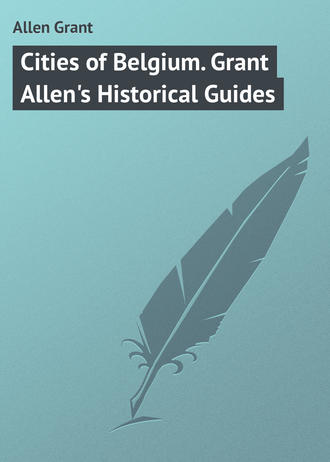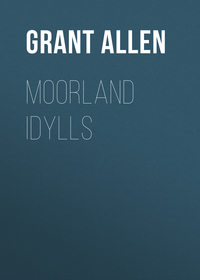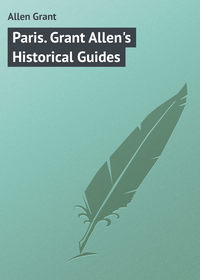 полная версия
полная версияCities of Belgium. Grant Allen's Historical Guides
180. Gossaert: group of figures somewhat strangely known as “The Just Judges.” Probably a single surviving panel from an extensive work of the same character as the Adoration of the Lamb at Ghent.
263. Jan Mostaert: *very fine portrait of a man in a large black hat and yellow doublet. Pendant to 264.
558. Holy Family. Dutch School. Early 16th century.
202. Lucas van Leyden: *portraits. Characteristic, and well thrown out against the background.
566. School of Quentin Matsys: a genre piece; an unpleasant representation of a young girl attempting to cut the purse strings of an old man. Probably a companion picture to one now in the possession of the Countess of Pourtalés, Paris.
Above these, 168, Triptych by Fyol, German School. Centre, the Adoration of the Magi. The Old King has removed his crown, as usual, and presented his gift. He is evidently a portrait: he wears a collar of the Golden Fleece, and is probably Philippe le Bon. Behind him, the Middle-aged King, kneeling; then the Young King, a Moor, with his offering. (The story of the Three Kings – Gaspar, Melchior, Balthasar – was largely evolved in the Cologne district, where their relics formed the main object of pious pilgrimage.) To the R., an undignified Joseph, with his staff, and the peculiar robe with which you are now, I hope, familiar. In the background, the family of the donor, looking in through a window. The wings have, I think, been misplaced. L., The Circumcision; R., Nativity: notice the ox and ass, and the costume of Joseph.
325. Schoreel: Crucifixion, with Our Lady, St. John, the Magdalen, and angels catching the Holy Blood. (A frequent episode.)
Above it, 570, School of Gossaert: Our Lady.
262. Jan Mostaert: The Prophecies of Our Lady. Above, she is represented as Queen of Heaven, in an oval glory of angels, recalling the Italian mandorla. Below, those who have prophesied of her: in the centre, Isaiah, with scroll, “Behold, a Virgin shall conceive,” etc.: R. and L., Micah and Zechariah. Further R. and L., two Sibyls. The one to the R. is the same person as 264.
567. School of Quentin Matsys: Favourite subject of the Miser.
25. More monstrosities by Bosch.
Beyond the door,
534. Unknown: Flemish School: Assumption of Our Lady. Above, the Trinity waiting to crown her.
123. Dunwege: German School. The Family of St. Anne, resembling in subject the Quentin Matsys at Brussels. Centre, St. Anne enthroned. Below her, Our Lady and the Divine Child. (Often Our Lady sits on St. Anne’s lap.) L., Joachim offers St. Anne and Our Lady cherries. (See Legends of the Madonna.) R., St. Joseph, with his staff and robe. On either side, the Maries, with their children, here legibly named, and their husbands. (From a church at Calcar.)
Above this, 523. Triptych: Madonna and Child, with donors and patron saints (Sebastian and Mary Magdalen). Note their symbols. On either side,
Van der Meire: 388: Mater Dolorosa; her breast pierced with a sword: and on the other side of the triptych 389 (attribution doubtful, according to Lafenestre), a donatrix with St. Catherine, holding the sword of her martyrdom.
569. School of Gossaert, Way to Calvary, with the usual brutal soldiers.
47. Herri Met de Bles: Repose on the Flight into Egypt. Notice the sleeping St. Joseph, and the staff, basket, and gourd, which mark this subject.
539. Good unknown Flemish portrait.
Beyond this, a frame containing five excellent small pictures.
243. Quentin Matsys: *St. Mary Magdalen with her alabaster box. Sweet and simple. In reality, portrait of an amiable round-faced Flemish young lady, in the character of her patron saint. Her home forms the background.
526 and 538. Fine unknown portraits.
199. *Exquisite and delicate miniature by Hans Holbein the Younger. (Lafenestre doubts the attribution.)
132. Fouquet, the old French painter, 1415-1485. Hard old French picture of a Madonna and Child, of the regal French type, with solid-looking red and blue cherubs. Said to be a portrait of Agnes Sorel, mistress of Charles VII. From the Cathedral of Melun.
Then, another case, containing six delicate works of the first importance.
396. *Roger van der Weyden (more probably, School of Van Eyck): Annunciation. The angel Gabriel, in an exquisitely painted bluish-white robe, has just entered. Our Lady kneels at her prie-dieu with her book. In the foreground, the Annunciation lily; behind, the bed-chamber. The Dove descends upon her head. This is one of the loveliest works in the collection.
253. Memling: **Exquisite portrait of a Premonstratensian Canon.
28. Dierick Bouts: The Madonna and Child. An excellent specimen of his hard, careful manner.
203. Lucas of Leyden: David playing before Saul.
30. Bril, 1556-1626. Fine miniature specimen of later Flemish landscape, with the Prodigal Son in the foreground.
559. Unknown but admirable portrait of a man.
223. Justus van Ghent: Nativity, with Adoration of the Shepherds. A good picture, full of interesting episodes.
Beyond these, another case, containing fine small works. A beautiful little *Madonna with the Fountain of Life (411) by Jan van Eyck, closely resembling a large one by Meister Wilhelm, in the Museum at Cologne. Two good unknown portraits. A splendid **portrait of a medallist (5) by Antonello da Messina (sometimes attributed to Memling). A portrait (33) of François II. of France as a child, by Clouet, of the old French School. A characteristic *Albert Dürer (124), portrait of Frederick III. of Saxony: and a good Gossaert (182). These do not need description, but should be closely studied.
The place of honour on this wall is occupied by 393, a magnificent **Seven Sacraments, usually attributed to Roger van der Weyden, though believed by some to be a work of his master, Robert Campin of Tournai. At any rate, it is a work full of Roger’s mystic spirit. In form, it is a triptych, but the main subjects are continued through on to the wings. The central panel represents the Sacrament of the Mass, typified in the foreground by a Crucifixion, taking place in the nave of an unknown Gothic church. At the foot of the cross are the fainting Madonna, supported by St. John (in red as usual) and a touching group of the three Maries. The robe of one to the left overflows into the next panel. In the background, the actual Mass is represented as being celebrated at the High Altar. The architecture of the church (with its triforium, clerestory, and apse, and its fine reredos and screen) is well worth notice. So are the figures of Our Lady, St. Peter and St. John, on the decorative work of the screen and reredos. I believe the kneeling figure behind the officiating priest to be a portrait of the donor. The side panels represent the other sacraments, taking place in the aisles and lateral chapels of the same church. L., Baptism, Confirmation, Confession: in the Confirmation, the children go away wearing the sacred bandage. R., Holy Orders, Matrimony, Extreme Unction. Each of these groups should be carefully noted. The colours of the angels above are all symbolical: – white (innocence) for Baptism: yellow (initiation) for Confirmation: red (love or sin) for confession and absolution: green (hope) for the Eucharist: purple (self-sacrifice) for Holy Orders: blue (fidelity) for Marriage: violet, almost black, (death) for Extreme Unction. The picture is full of other episodes and mystical touches. In all this beautiful and touching composition, the Mary to the right of the Cross is perhaps the most lovely portion. For a fine criticism, see Conway.
Beyond this, another frame with exquisite small works.
250. Quentin Matsys: Head of Christ, with the Crown of Thorns and Holy Blood; painful.
540. Admirable unknown miniature portrait.
544. Excellent little St. Helena.
542. A little donor, with his patron, St. John.
204, 205, 206. Good Lucas of Leyden, of the Four Evangelists (John missing). Luke, with the bull, painting; Matthew, with the angel, and Mark, with the lion, writing.
537. Admirable unknown portrait. These little works again need no description, but close study.
Above them, 244. Quentin Matsys (?). The Misers, one of the best known of this favourite subject.
Then, another frame of miniatures.
517, 518. Unknown Flemish 14th century Madonna and Child, with donor and wife.
541, 522. Tolerable portraits.
545. Fine portrait, of the Spanish period.
410. **Van Eyck’s celebrated unfinished St. Barbara, holding her palm of martyrdom, and with her tower in the background. It should be closely studied, both as an indication of the master’s method, and as a contemporary drawing illustrating the modes of mediæval building. For a careful criticism, see Conway.
Above these, Engelbrechtsen, 130. St. Hubert, attired as bishop, bearing his crozier and hunting horn, and with the stag beside him, with the crucifix between its horns.
127. The same. St. Leonard releasing prisoners.
Then, another case of good small pictures.
3. A Fra Angelico. Interesting in the midst of these Flemish pictures. St. Romuald reproaching the Emperor Otho III. for the murder of Crescentius.
32. Petrus Christus (?). A donor and his patron, St. Jerome.
64. A landscape by Patinir.
536. A Baptism of Christ, where note the conventional arrangement and the angel with the robe.
561. Triptych. Madonna and Child. St. Christopher, and St. George. Harsh and angular.
548. Mater Dolorosa, transpierced by the sword.
535. Good Flemish Madonna with angels.
207. Lucas of Leyden: Adoration of the Magi. You can now note for yourself the ox, ass, Joseph, position, age, and complexion of Kings, etc.
29. Attributed (doubtfully) to Dierick Bouts: St. Christopher wading, with the Infant Christ. In the background, the hermit and lantern. (See Mrs. Jameson.)
176. Giotto: A St. Paul with the sword. Characteristic of early Florentine work.
257, 258, 259, 260. Simone Martini of Siena: Four panels. Extreme ends, **Annunciation, closely resembling the figures in the Ufizzi at Florence: Annunciations are often thus divided into two portions. Centre, Crucifixion and Descent from the Cross. These exquisitely finished little works are full of the tender and delicate spirit of the early Sienese School. In the Crucifixion, notice particularly the Magdalen, and St. Longinus piercing the side of Christ. Our Lady in the Annunciation has the fretful down-drawn mouth inherited by early Italian art from its Byzantine teachers.
177. Giotto: St. Nicolas of Myra with the three golden balls, protecting a donor.
Above are three good portraits by Van Orley, and other works which need no description.
On easels at the end, 255. Attributed to Memling: **Exquisite Madonna and Child in a church. Our Lady, arrayed as Queen of Heaven, with a pot of lilies before her, stands in the nave of a lovely early Gothic cathedral, with a later Decorated apse, and admirable rood-screen. Every detail of the tiles, the crown, the screen, and the robe, as well as Our Lady’s hair and hands, should be closely looked into. This is one of the loveliest pictures here. It is a very reduced copy from one by Jan van Eyck at Berlin: the church is that of the Abbey of the Dunes near Furnes. Its attribution to Memling has been disputed: Conway believes it to be by a follower. In any case, it is lovely.
256. **Companion panel, of the donor, a Cistercian Abbot of the Dunes, in a sumptuous room, half bed-chamber, half study, with a beautiful fireplace and fire. He kneels at his prayers, having deposited his mitre on a cushion beside him, and laid his crozier comfortably by the fireplace. Creature comforts are not neglected on the side-board. Here also every decorative detail should be closely examined. These are two of the very finest works of the School of Memling. Probably the Abbot admired Jan van Eyck’s Madonna, painted for a predecessor, and asked for a copy, with himself in adoration on the other wing of the diptych.
At the back, on a revolving pivot,
530, 531. Christ blessing, and a Cistercian Canon in adoration. As usual, the outer panels are less brilliant in colouring than the inner. Notice the Alpha and Omega and the P. and F. (for Pater and Filius) on the curtain behind the Saviour. These works are by an inferior hand.
The other easel has a fine (208, 209, 210) *Lucas van Leyden: Adoration of the Magi, with fantastic elongated figures. Note the ruined temple. The other features will now be familiar. Lucas’s treatment is peculiar. L., St. George and the Dragon. The saint has broken his lance and attacks the fearsome beast with his sword. In the background, the Princess Cleodolind and landscape. R., The donor, in a rich furred robe, and behind him, St. Margaret with her dragon. At the back, 181, wings, by the same, with a peculiar Annunciation (the wings being open, reversed in order). Between them has been unwisely inserted an Ecce Homo by Gossaert.
Now, go straight through Rooms H, F, and E, to three rooms en suite, the last of which is
Room A,containing the Transitional Pictures. (It is usual to skip these insipid works of the intermediate age, and to jump at once from the School of Van Eyck to the School of Rubens – I think unwisely – for Rubens himself can only properly be appreciated as the product of an evolution, by the light of the two main influences which affected him – his Flemish masters, and his Italian models, Veronese and Giulio Romano.) Begin at the far end, near the lettered doorway, and note throughout the effort to imitate Italian art; the endeavour at classical knowledge; and the curious jumble of Flemish and Tuscan ideas. But the Flemish skill in portraiture still continues.
698. Good portrait of Giles van Schoonbeke, by P. Pourbus.
Next to it, 103, Martin De Vos, the Elder: St. Anthony the Abbot, accompanied by his pig and bell, and his usual tempters, burying the body of St. Paul the Hermit, whose grave two lions are digging. To the R., hideous Flemish devils, grotesquely horrible. Above, phases of the Temptation of St. Anthony.
372. Michael Coxcie: Martyrdom of St. George – one of his tortures. Good transitional work, inspired by Italian feeling.
72. M. De Vos: Triptych, painted for the altar of the Guild of Crossbowmen in the Cathedral. Centre, Triumph of the risen Christ. In the foreground, St. Peter (keys), and St. Paul (sword), with open pages of their writings. L., St. George, patron of the Crossbowmen, with his banner and armour; R., St. Agnes with her lamb. Left panel, Baptism of Constantine by St. Sylvester. Right panel, Constantine ordering the erection of the Church of St. George at Constantinople. In the sky, the apparition of Our Lady to the Emperor. A gigantic work, recalling the later Italian Renaissance, especially the Schools of Bronzino and Giulio Romano.
374. Michael Coxcie: Martyrdom of St. George; the other wing of the same triptych in honour of St. George as 372; central portion lost.
89. M. De Vos: St. Conrad of Ascoli, a Franciscan friar, in devout contemplation of the founder of his Order, St. Francis, receiving the Stigmata. Around it, small scenes from the life of St. Conrad, unimportant. Below, Devotion at the tomb of St. Conrad: royal personages praying, offerings of rich images, and the sick healed by his relics. A curious picture of frank corpse-worship.
699. Good portrait by Pourbus.
576. Triptych, unknown. St. Eligius of Noyon (St. Éloy), one of the apostles of Brabant, preaching to a congregation really composed of good local portraits. (A pious way of having oneself painted.) R. and L., St. Eligius feeding prisoners, and St. Eligius healing the sick.
741. Another of Bernard van Orley’s General Resurrections, the type of which will now be familiar to you. In the centre, strangely introduced group of portraits of the donors, engaged in burying a friend, whose memory this triptych was doubtless intended to commemorate. On either wing, the six works of Mercy (the seventh, burial, is in the main picture).
77. Good transitional triptych, by M. De Vos, for the Guild of Leather-dressers. Centre, The Incredulity of St. Thomas. On the wings, Scenes from the life of the Baptist. L., Baptism of Christ; where note the persistence of the little symbolical Jordan, with angels almost inconspicuous. R., The Decollation of St. John. Salome receiving his head in a charger. In the background, Herodias.
371. Coxcie the Younger: Martyrdom of St. Sebastian, patron saint of Bowmen, from their altar in the Cathedral. An attempt to be very Italian. The wings of this triptych are by Francken. L., St. Sebastian exhorting Marcus and Marcellinus to go to martyrdom. R., St. Sebastian miraculously healing the dumb woman, with portrait spectators, in dress of the period, deeply interested.
Now go on into
Room B,(unlettered, the centre of the three). It contains works of an earlier period.
The left wall is entirely occupied by three large panels of a fine old Flemish 15th century picture, attributed to Memling (and apparently accepted as his by Lafenestre), representing *Christ Enthroned, with orb and cross, surrounded by choirs of angels; those in the central panel singing; the others, playing various musical instruments. This is a beautiful work, but less pleasing than those of the same school on a smaller scale. It has been recently bought from the monastery of Najera in Spain. It was intended, I think, to be seen at a height, probably on an organ-loft, and loses by being placed so near the eye of the spectator.
The opposite wall, R., is occupied by 245, Quentin Matsys’s masterpiece, the triptych of **the Entombment, painted for the altar of the Guild of Cabinet-makers. The colouring is much more pleasing than in the Family of St. Anne at Brussels. Central panel, The Entombment. Nicodemus supports the emaciated body of the dead Saviour, while Joseph of Arimathea wipes the marks of the crown of thorns from his head. The worn body itself, with a face of pathetic suffering, lies on the usual white sheet in the foreground. At the foot, Mary Magdalen, with her pot of ointment and long fair hair, strokes the body tenderly. In the centre is the fainting Madonna, supported, as always, by St. John, in his red robe. Behind are the three Maries. The usual attendant (a ruffianly Fleming, in a queer turban-like cap) holds the crown of thorns. At the back, preparations for the actual placing in the sepulchre. In the background, Calvary.
The wings have scenes from the lives of the two St. Johns. L., The daughter of Herodias, a very mincing young lady, in a gorgeous dress, brings the head of St. John the Baptist on a charger to her mother and a fiercely-bearded Herod. The queen appears to be about to carve it. Above, a gallery of minstrels. Admirable drapery and accessories. The R. wing has the so-called Martyrdom of St. John the Evangelist, in the cauldron of boiling oil, with a delightful boy spectator looking on in a tree. The Emperor Domitian (older than history), on a white horse, behind. Flemish varlets stir the fire lustily. This noble work originally decorated the altar in the Chapel of the Menuisiers of Antwerp in the Cathedral.
On easels, 649, Claeissens: Triptych of the Crucifixion, with the Way to Calvary and the Resurrection. Elongated, attenuated figures.
680. Giles Mostaert (the elder): Singular complex picture, painted for the Hospital of Antwerp; representing, above, The General Resurrection: Christ enthroned between Our Lady and St. John-Baptist. Beneath, naked souls rising from the tomb. To the L., St. Peter welcomes the just at the gate of the Celestial City. To the R., devils drive the wicked into the gaping jaws of Hell. Beneath, the courses that lead to either end: the Seven Works of Mercy, inspired by the Redeemer, and the Seven Deadly Sins, suggested by devils. I will leave you to identify them (it is easy).
Go on into
Room D,containing more works of the Transition. These large altar-pieces of the early 17th century, the period of the greatest wealth in Antwerp, though often frigid, as works of art, are at least interesting as showing the opulence and the tastes of the Antwerp guilds during the epoch of the Spanish domination. They are adapted to the huge Renaissance churches then erected, as the smaller triptychs of the 15th century were adapted to the smaller Gothic altars.
529. Feast of Archers, with the King of the Archers enthroned in the background.
696, 697. Tolerable portraits by Pourbus.
183. A Madonna by Gossaert.
114. Frans Floris: St. Luke painting, with his bull most realistically assisting, and his workman grinding his colours. From the old Academy of Painters, whose patron was St. Luke. Italian influence.
135. Ambrose Francken: Loaves and fishes.
148. The same. Decollation of St. Cosmo and St. Damian: painted for the Guild of Physicians, of whom these were the patron saints.
357. A splendid and luminous Titian, in the curious courtly ceremonial manner of the Venetian painters. **Pope Alexander VI. (Borgia), in a beautiful green dalmatic, introducing to the enthroned St. Peter his friend, Giovanni Sforza da Pesaro, Bishop of Paphos, and admiral of the Pope’s fleet. At the bishop’s feet lies his helmet, to show his double character as priest and warrior. He grasps the banner of the Borgias and of the Holy Church. In the background (to show who he is), the sea and fleet. St. Peter’s red robe is splendid. The Venetians frequently paint similar subjects, – “Allow me to introduce to your Sainthood,” etc. This is a fine work in Titian’s early harder manner, still somewhat reminiscent of the School of Bellini. Its glorious but delicate colour comes out all the better for the crudity of the works around it.
146. Ambrose Francken: St. Cosmo and St. Damian, the Doctor Saints, amputating an injured leg, and replacing it by the leg of a dead Moor. In the background, other episodes of their profession. (Wing of the triptych for the Guild of Physicians.)
83. M. De Vos: Triptych, painted for the Guild of the Mint, and allusive to their functions. Centre, The Tribute Money. “Render unto Cæsar,” etc., with tempting Pharisees and Sadducees, and Roman soldiers. In the foreground, St. Peter in blue and yellow, with his daughter Petronilla. Left wing: Peter, similarly habited, finds the tribute money in the fish’s mouth. Right wing: The Widow’s Mite. (The French titles, “Le Denier de César,” “Le Denier du Tribut,” “Le Denier de la Veuve,” bring out the allusion better.)
88. M. De Vos: St. Luke painting Our Lady, with his bull, as ever, in attendance. The wings by others. L., St. Luke preaching. R., St. Paul before Felix. From the altar of the (painters’) Confraternity of St. Luke in the Cathedral.
113. Frans Floris: Adoration of the Shepherds. Note persistence of formal elements from old School, with complete transformation of spirit.
663. Floris: Judgement of Solomon.
112. Frans Floris’s horrible St. Michael conquering the devils; the most repulsive picture by this repulsive and exaggerated master.
Right and left of it, good late Flemish portraits of donors.
483. Portrait by Van Veen, Rubens’s master.
Room Econtains chiefly works of the school of Rubens, most of which can now be satisfactorily comprehended by the reader without much explanation. I will therefore treat them briefly.
Left of the door,
82. A Nativity, by De Vos. Can be instructively compared with earlier examples.
57. Good 17th century landscape.
646. Attributed to Brueghel: Paying tithes.
644. P. Brueghel the Younger: A village merry-making (“Kermesse Flamande”). With more than the usual vulgarity of episode.
722 and 724. Capital portraits.
Good Still life, etc.
Room Fcontains nothing which the reader cannot adequately understand for himself. Omit Room G for the present (it contains the Dutch Masters), and turn instead into
Room H,mostly devoted to works of the School of Rubens.
End Wall, 305. Rubens: *The Last Communion of the dying St. Francis of Assisi. A famous work, in unusually low tones of colour – scarcely more than chiaroscuro. St. Francis, almost nude, is supported by his friars. Above, angels, now reduced to cherubs, wait to convey his soul to Heaven. Painted for the altar of St. Francis in the Franciscan Church of the Récollets. See it from the far end of the room, where it becomes much more luminous.









